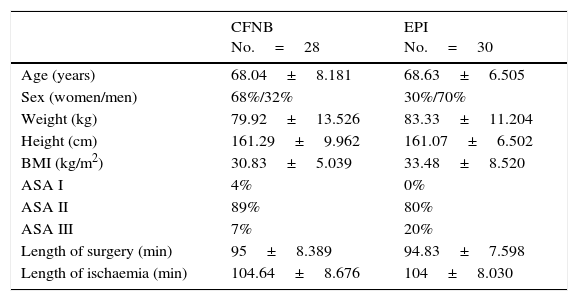Total knee arthroplasty is associated with severe postoperative pain. The aim of this study was to compare continuous ultrasound-guided femoral nerve block with continuous epidural analgesia, both with low concentrations of local anaesthetic after total knee arthroplasty.
Material and methodsA prospective, randomised, unblinded study of 60 patients undergoing total knee replacement, randomised into two groups. A total of 30 patients received continuous epidural block, while the other 30 received continuous ultrasound-guided femoral nerve block, as well as using 0.125% levobupivacaine infusion in both groups. Differences in pain control, undesirable effects, and complications between the two techniques were assessed, as well as the need for opioid rescue and the level of satisfaction with the treatment received during the first 48h after surgery.
ResultsNo differences were found in demographic and surgical variables. The quality of analgesia was similar in both groups, although in the first six hours after surgery, patients in the epidural group had less pain both at rest and with movement (p=0.007 and p=0.011). This difference was not observed at 24h (p=0.084 and p=0.942). Pain control at rest in the femoral block group was better at 48h after surgery than in the epidural group (p=0.009). The mean consumption of morphine and level of satisfaction were similar. Epidural analgesia showed the highest rate of side effects (p=0.003).
ConclusionsContinuous ultrasound-guided femoral nerve block provides analgesia and morphine consumption similar to epidural analgesia, with the same level of satisfaction, but with a lower rate of side effects after total knee arthroplasty.
La artroplastia total de rodilla es una intervención asociada a dolor postoperatorio de severa intensidad. El objetivo de este estudio fue comparar el bloqueo continuo del nervio femoral ecoguiado con la analgesia epidural continua, ambos con bajas concentraciones de anestésico local en el postoperatorio inmediato de este proceso.
Material y métodosEstudio prospectivo aleatorizado no enmascarado de 60 pacientes intervenidos de prótesis total de rodilla aleatorizados en 2 grupos. Treinta pacientes recibieron un bloqueo epidural continuo mientras que los otros 30 recibieron un bloqueo continuo del nervio femoral ecoguiado, utilizando para la infusión levobupivacaína 0,125% en ambos grupos. Se valoró la existencia de diferencias en cuanto al control del dolor, la aparición de efectos colaterales y complicaciones entre ambas técnicas, así como la necesidad de opiáceos de rescate y el grado de satisfacción con el tratamiento recibido durante las primeras 48h de postoperatorio.
ResultadosLa calidad de la analgesia fue similar en ambos grupos, aunque en las primeras 6h de postoperatorio los pacientes del grupo epidural presentaron menor dolor tanto en reposo como en movimiento (p=0,007 y p=0,011). Esta diferencia no se observó a las 24h (p=0,084 y p=0,942). A las 48h el control del dolor en reposo en el grupo bloqueo femoral fue mejor que en el epidural (p=0,009). El consumo medio de morfina y el grado de satisfacción fueron similares. La analgesia epidural presentó el mayor índice de efectos colaterales (p=0,003).
ConclusionesEl bloqueo continuo del nervio femoral ecoguiado proporciona una analgesia y un consumo de morfina similares a la analgesia epidural, con un mismo grado de satisfacción pero con menor índice de efectos colaterales en el postoperatorio de artroplastia total de rodilla.












